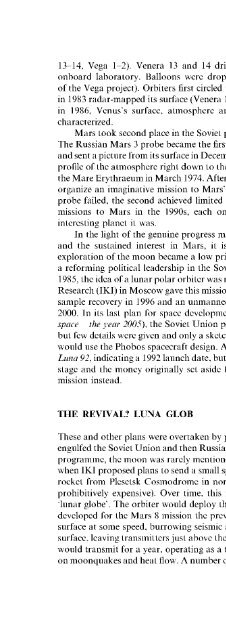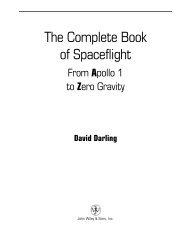Soviet and Russian Lunar Exploration
Soviet and Russian Lunar Exploration
Soviet and Russian Lunar Exploration
You also want an ePaper? Increase the reach of your titles
YUMPU automatically turns print PDFs into web optimized ePapers that Google loves.
13-14, Vega 1-2). Venera 13 <strong>and</strong> 14 drilled Venusian soil <strong>and</strong> analyzed it in an<br />
onboard laboratory. Balloons were dropped into the Venusian atmosphere (part<br />
of the Vega project). Orbiters first circled the planet in 1975 (Venera 9, 10) <strong>and</strong> then<br />
in 1983 radar-mapped its surface (Venera 15-16). By the end of the Vega programme<br />
in 1986, Venus's surface, atmosphere <strong>and</strong> circumplanetary space had been well<br />
characterized.<br />
Mars took second place in the <strong>Soviet</strong> programme for interplanetary exploration.<br />
The <strong>Russian</strong> Mars 3 probe became the first spacecraft to soft-l<strong>and</strong> on the Red Planet<br />
<strong>and</strong> sent a picture from its surface in December 1971. The <strong>Soviet</strong> Union obtained a full<br />
profile of the atmosphere right down to the surface during the descent of Mars 6 into<br />
the Mare Erythraeum in March 1974. After a gap of many years, the USSR went on to<br />
organize an imaginative mission to Mars's little moon, Phobos, in 1988-9 (the first<br />
probe failed, the second achieved limited success). The Americans began a wave of<br />
missions to Mars in the 1990s, each one revealing more <strong>and</strong> more of what an<br />
interesting planet it was.<br />
In the light of the genuine progress made in the successful exploration of Venus<br />
<strong>and</strong> the sustained interest in Mars, it is little wonder that the further scientific<br />
exploration of the moon became a low priority. Eventually, though, coinciding with<br />
a reforming political leadership in the <strong>Soviet</strong> Union, some plans were advanced. In<br />
1985, the idea of a lunar polar orbiter was resurrected. In 1987, the Institute for Space<br />
Research (IKI) in Moscow gave this mission a target gate of 1993, with a lunar farside<br />
sample recovery in 1996 <strong>and</strong> an unmanned laboratory on the moon, with rovers, in<br />
2000. In its last plan for space development published in 1989 (The USSR in outer<br />
space - the year 2005), the <strong>Soviet</strong> Union proposed a lunar polar geophysical orbiter,<br />
but few details were given <strong>and</strong> only a sketchy illustration was published, suggesting it<br />
would use the Phobos spacecraft design. At one stage, the project acquired the name<br />
Luna 92, indicating a 1992 launch date, but it never got beyond the preliminary design<br />
stage <strong>and</strong> the money originally set aside for it was used for the Mars 96 planetary<br />
mission instead.<br />
THE REVIVAL? LUNA GLOB<br />
These <strong>and</strong> other plans were overtaken by political events <strong>and</strong> the financial crisis that<br />
engulfed the <strong>Soviet</strong> Union <strong>and</strong> then Russia in the early 1990s. In the post-<strong>Soviet</strong> space<br />
programme, the moon was rarely mentioned. The first instance was in summer 1997,<br />
when IKI proposed plans to send a small spacecraft into lunar orbit, using a Molniya<br />
rocket from Plesetsk Cosmodrome in northern Russia in 2000 (a Proton would be<br />
prohibitively expensive). Over time, this mission acquired the title Luna Glob, or<br />
'lunar globe'. The orbiter would deploy three 250 kg penetrators, modelled on those<br />
developed for the Mars 8 mission the previous year. They would dive into the lunar<br />
surface at some speed, burrowing seismic <strong>and</strong> heat flow instruments under the lunar<br />
surface, leaving transmitters just above the surface. With small nuclear isotopes, they<br />
would transmit for a year, operating as a three-point network to collect information<br />
on moonquakes <strong>and</strong> heat flow. A number of variations on these themes appeared, but







